Economics Assignment: Wage, Surplus, and Trade Analysis
VerifiedAdded on 2020/06/04
|15
|1760
|347
Homework Assignment
AI Summary
This economics assignment solution provides a comprehensive analysis of various economic concepts. Part 1 focuses on wage determination, analyzing equilibrium, the impact of minimum wages, and the effects on consumer and producer surplus. Part 2 delves into elasticity, calculating income and price elasticity of demand and supply. Part 3 explores market equilibrium, consumer and producer surplus calculations, and the implications of tariffs and free trade on domestic and international markets, including discussions on ethical considerations like bonded labor and slavery. The assignment references several academic sources to support its analysis.
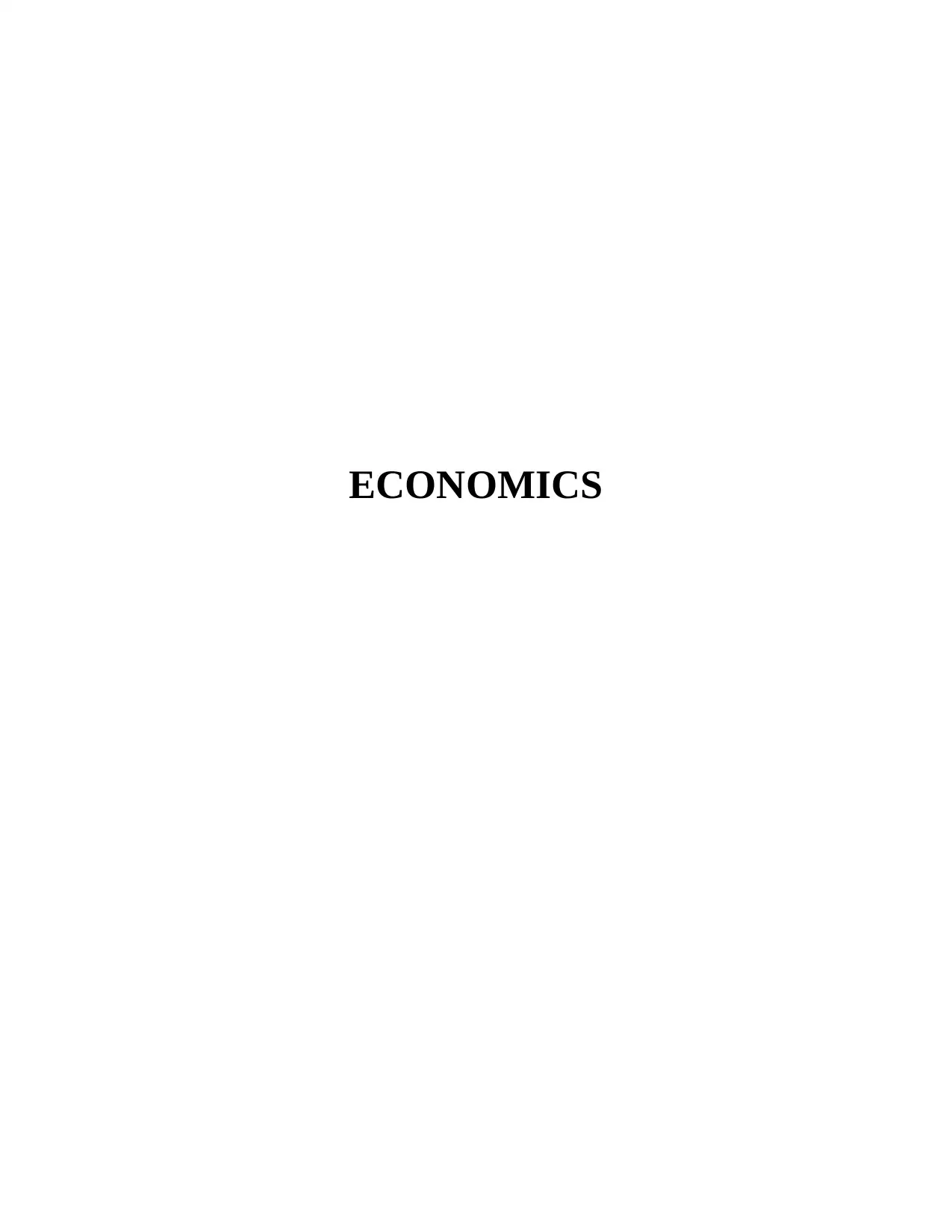
ECONOMICS
Paraphrase This Document
Need a fresh take? Get an instant paraphrase of this document with our AI Paraphraser
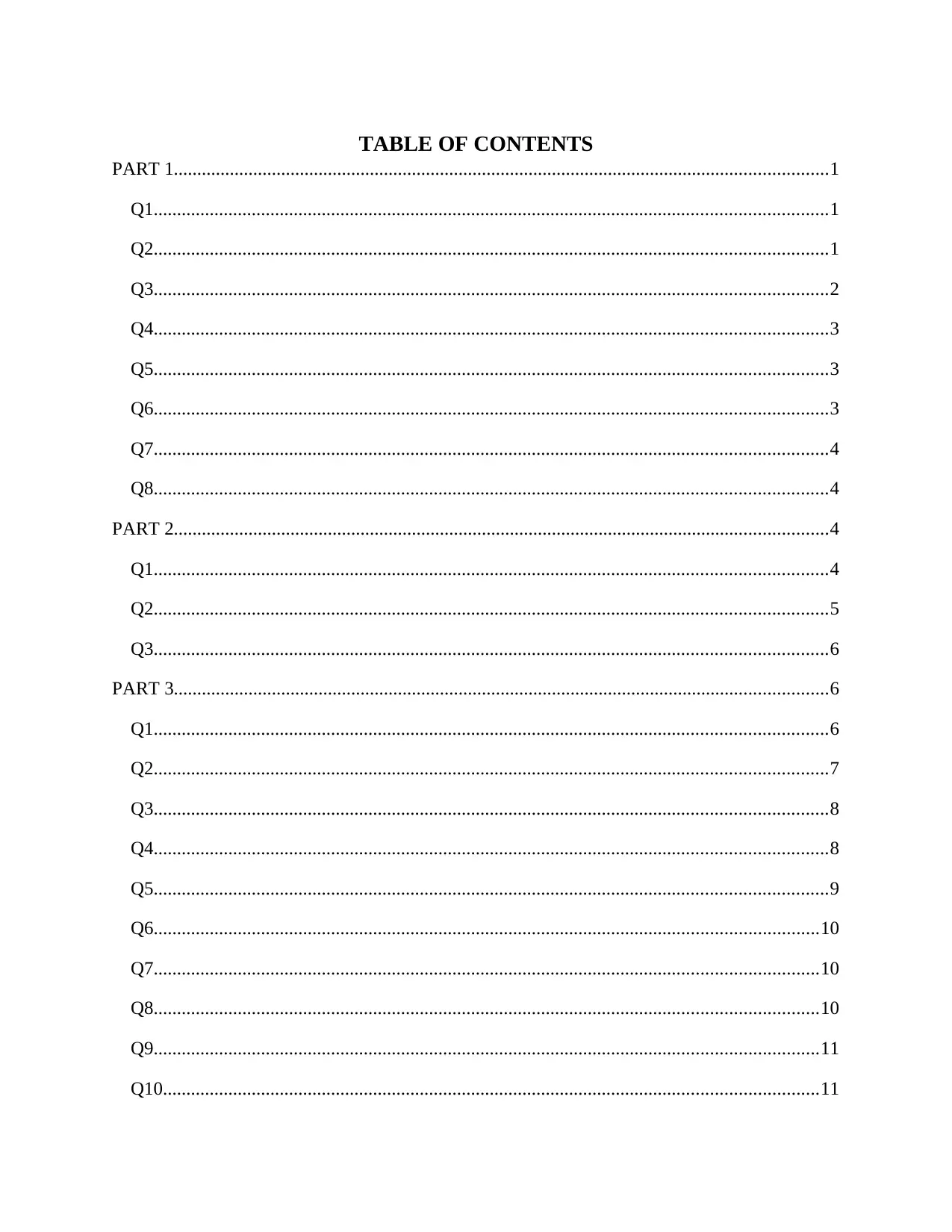
TABLE OF CONTENTS
PART 1............................................................................................................................................1
Q1................................................................................................................................................1
Q2................................................................................................................................................1
Q3................................................................................................................................................2
Q4................................................................................................................................................3
Q5................................................................................................................................................3
Q6................................................................................................................................................3
Q7................................................................................................................................................4
Q8................................................................................................................................................4
PART 2............................................................................................................................................4
Q1................................................................................................................................................4
Q2................................................................................................................................................5
Q3................................................................................................................................................6
PART 3............................................................................................................................................6
Q1................................................................................................................................................6
Q2................................................................................................................................................7
Q3................................................................................................................................................8
Q4................................................................................................................................................8
Q5................................................................................................................................................9
Q6..............................................................................................................................................10
Q7..............................................................................................................................................10
Q8..............................................................................................................................................10
Q9..............................................................................................................................................11
Q10............................................................................................................................................11
PART 1............................................................................................................................................1
Q1................................................................................................................................................1
Q2................................................................................................................................................1
Q3................................................................................................................................................2
Q4................................................................................................................................................3
Q5................................................................................................................................................3
Q6................................................................................................................................................3
Q7................................................................................................................................................4
Q8................................................................................................................................................4
PART 2............................................................................................................................................4
Q1................................................................................................................................................4
Q2................................................................................................................................................5
Q3................................................................................................................................................6
PART 3............................................................................................................................................6
Q1................................................................................................................................................6
Q2................................................................................................................................................7
Q3................................................................................................................................................8
Q4................................................................................................................................................8
Q5................................................................................................................................................9
Q6..............................................................................................................................................10
Q7..............................................................................................................................................10
Q8..............................................................................................................................................10
Q9..............................................................................................................................................11
Q10............................................................................................................................................11

REFERENCES..............................................................................................................................12
⊘ This is a preview!⊘
Do you want full access?
Subscribe today to unlock all pages.

Trusted by 1+ million students worldwide
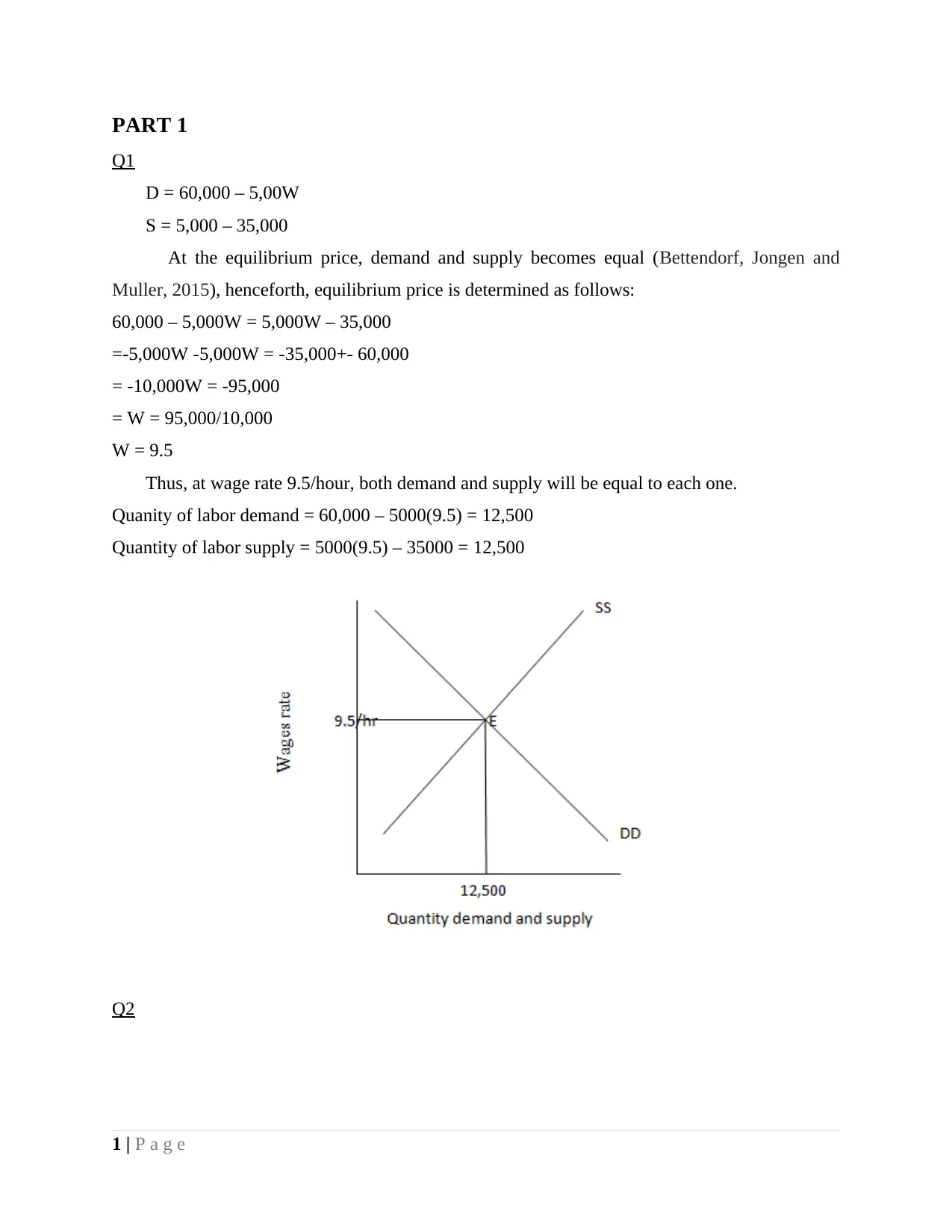
PART 1
Q1
D = 60,000 – 5,00W
S = 5,000 – 35,000
At the equilibrium price, demand and supply becomes equal (Bettendorf, Jongen and
Muller, 2015), henceforth, equilibrium price is determined as follows:
60,000 – 5,000W = 5,000W – 35,000
=-5,000W -5,000W = -35,000+- 60,000
= -10,000W = -95,000
= W = 95,000/10,000
W = 9.5
Thus, at wage rate 9.5/hour, both demand and supply will be equal to each one.
Quanity of labor demand = 60,000 – 5000(9.5) = 12,500
Quantity of labor supply = 5000(9.5) – 35000 = 12,500
Q2
1 | P a g e
Q1
D = 60,000 – 5,00W
S = 5,000 – 35,000
At the equilibrium price, demand and supply becomes equal (Bettendorf, Jongen and
Muller, 2015), henceforth, equilibrium price is determined as follows:
60,000 – 5,000W = 5,000W – 35,000
=-5,000W -5,000W = -35,000+- 60,000
= -10,000W = -95,000
= W = 95,000/10,000
W = 9.5
Thus, at wage rate 9.5/hour, both demand and supply will be equal to each one.
Quanity of labor demand = 60,000 – 5000(9.5) = 12,500
Quantity of labor supply = 5000(9.5) – 35000 = 12,500
Q2
1 | P a g e
Paraphrase This Document
Need a fresh take? Get an instant paraphrase of this document with our AI Paraphraser
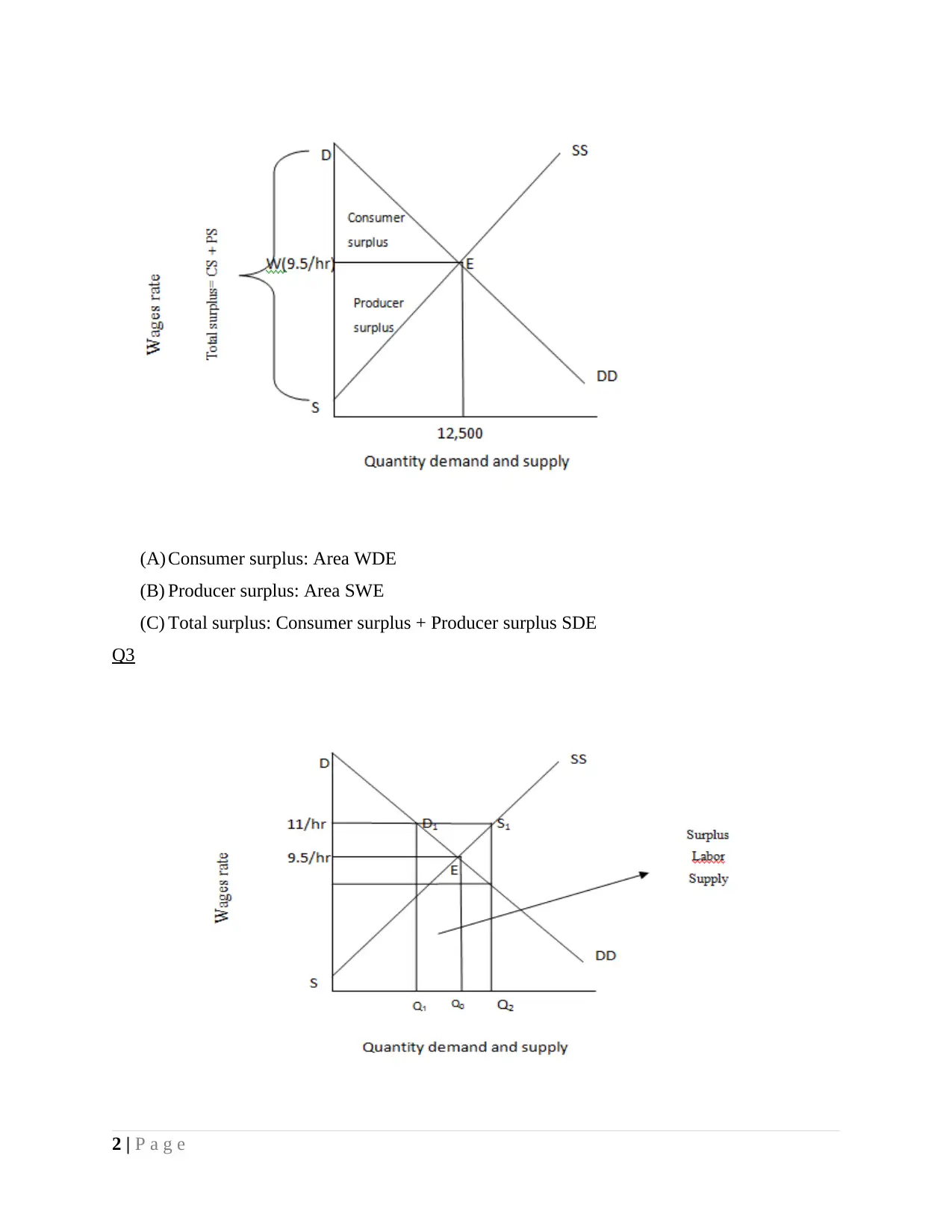
(A) Consumer surplus: Area WDE
(B) Producer surplus: Area SWE
(C) Total surplus: Consumer surplus + Producer surplus SDE
Q3
2 | P a g e
(B) Producer surplus: Area SWE
(C) Total surplus: Consumer surplus + Producer surplus SDE
Q3
2 | P a g e
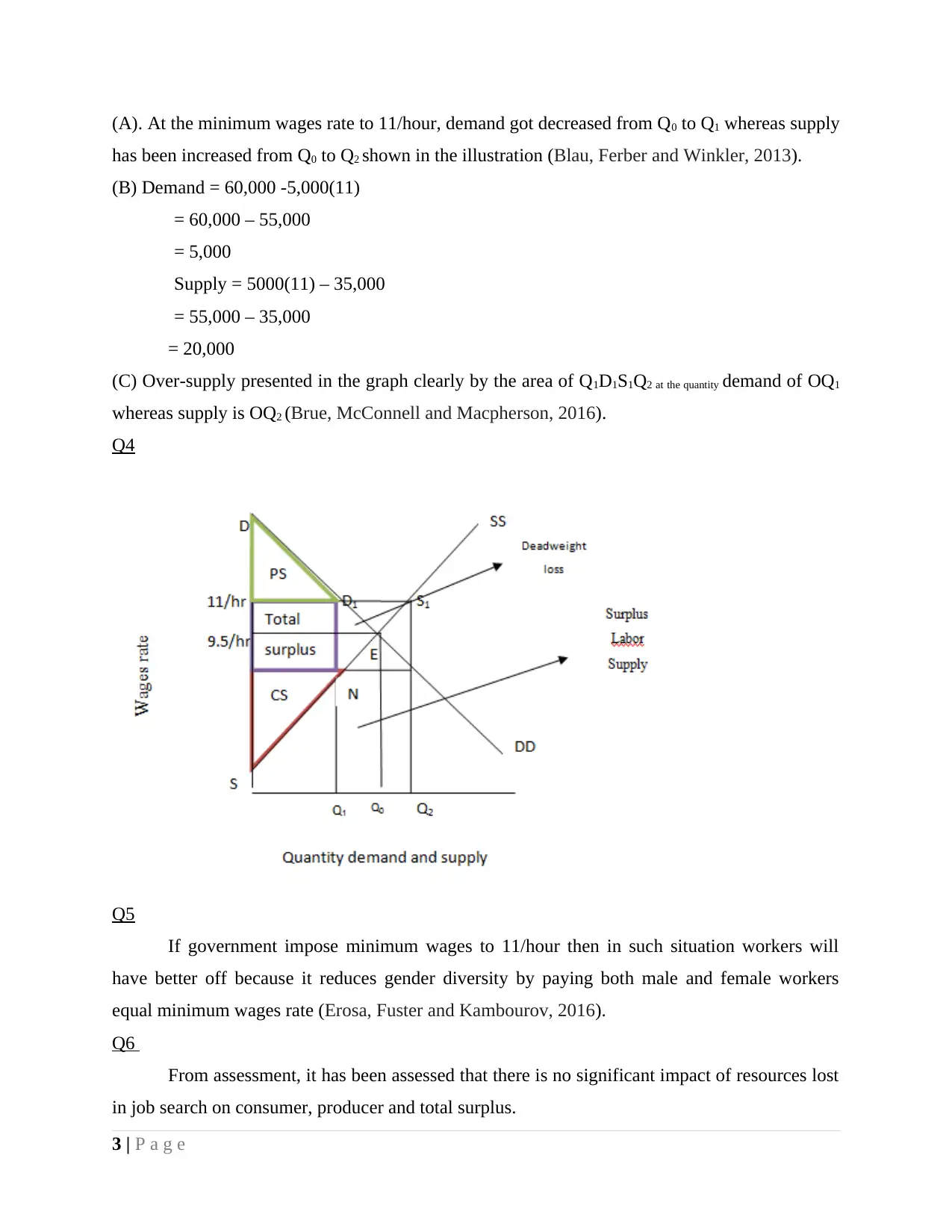
(A). At the minimum wages rate to 11/hour, demand got decreased from Q0 to Q1 whereas supply
has been increased from Q0 to Q2 shown in the illustration (Blau, Ferber and Winkler, 2013).
(B) Demand = 60,000 -5,000(11)
= 60,000 – 55,000
= 5,000
Supply = 5000(11) – 35,000
= 55,000 – 35,000
= 20,000
(C) Over-supply presented in the graph clearly by the area of Q1D1S1Q2 at the quantity demand of OQ1
whereas supply is OQ2 (Brue, McConnell and Macpherson, 2016).
Q4
Q5
If government impose minimum wages to 11/hour then in such situation workers will
have better off because it reduces gender diversity by paying both male and female workers
equal minimum wages rate (Erosa, Fuster and Kambourov, 2016).
Q6
From assessment, it has been assessed that there is no significant impact of resources lost
in job search on consumer, producer and total surplus.
3 | P a g e
has been increased from Q0 to Q2 shown in the illustration (Blau, Ferber and Winkler, 2013).
(B) Demand = 60,000 -5,000(11)
= 60,000 – 55,000
= 5,000
Supply = 5000(11) – 35,000
= 55,000 – 35,000
= 20,000
(C) Over-supply presented in the graph clearly by the area of Q1D1S1Q2 at the quantity demand of OQ1
whereas supply is OQ2 (Brue, McConnell and Macpherson, 2016).
Q4
Q5
If government impose minimum wages to 11/hour then in such situation workers will
have better off because it reduces gender diversity by paying both male and female workers
equal minimum wages rate (Erosa, Fuster and Kambourov, 2016).
Q6
From assessment, it has been assessed that there is no significant impact of resources lost
in job search on consumer, producer and total surplus.
3 | P a g e
⊘ This is a preview!⊘
Do you want full access?
Subscribe today to unlock all pages.

Trusted by 1+ million students worldwide
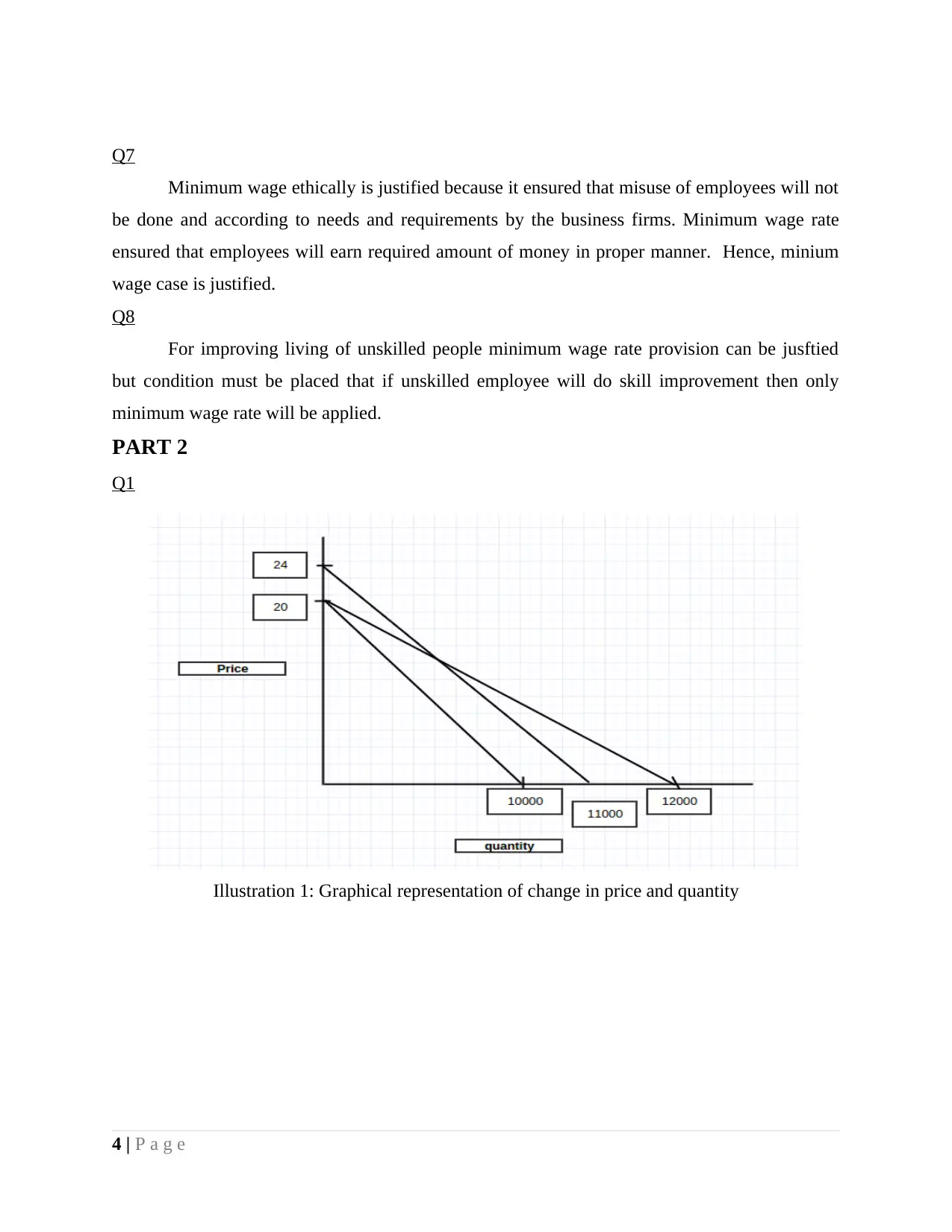
Q7
Minimum wage ethically is justified because it ensured that misuse of employees will not
be done and according to needs and requirements by the business firms. Minimum wage rate
ensured that employees will earn required amount of money in proper manner. Hence, minium
wage case is justified.
Q8
For improving living of unskilled people minimum wage rate provision can be jusftied
but condition must be placed that if unskilled employee will do skill improvement then only
minimum wage rate will be applied.
PART 2
Q1
4 | P a g e
Illustration 1: Graphical representation of change in price and quantity
Minimum wage ethically is justified because it ensured that misuse of employees will not
be done and according to needs and requirements by the business firms. Minimum wage rate
ensured that employees will earn required amount of money in proper manner. Hence, minium
wage case is justified.
Q8
For improving living of unskilled people minimum wage rate provision can be jusftied
but condition must be placed that if unskilled employee will do skill improvement then only
minimum wage rate will be applied.
PART 2
Q1
4 | P a g e
Illustration 1: Graphical representation of change in price and quantity
Paraphrase This Document
Need a fresh take? Get an instant paraphrase of this document with our AI Paraphraser
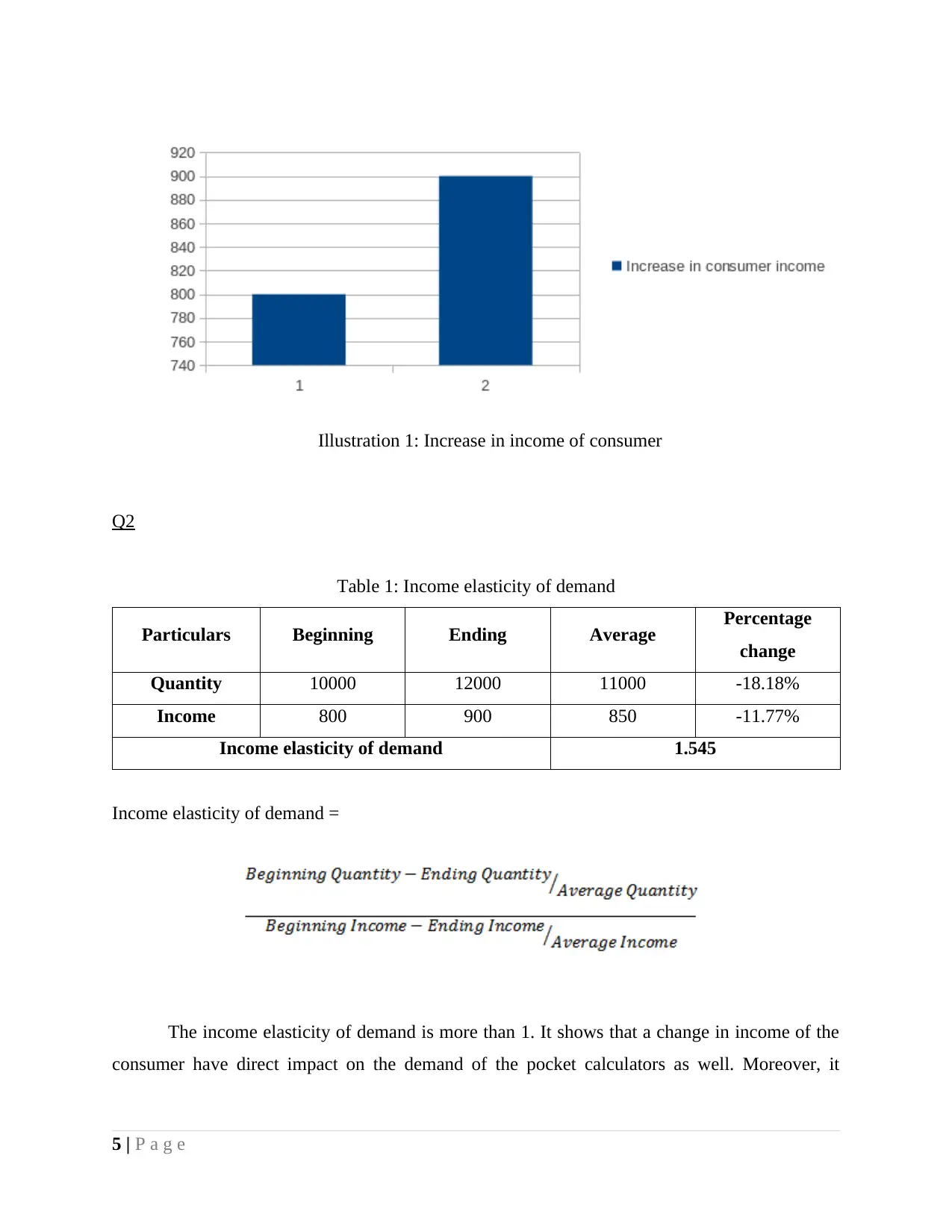
Q2
Table 1: Income elasticity of demand
Particulars Beginning Ending Average Percentage
change
Quantity 10000 12000 11000 -18.18%
Income 800 900 850 -11.77%
Income elasticity of demand 1.545
Income elasticity of demand =
The income elasticity of demand is more than 1. It shows that a change in income of the
consumer have direct impact on the demand of the pocket calculators as well. Moreover, it
5 | P a g e
Illustration 1: Increase in income of consumer
Table 1: Income elasticity of demand
Particulars Beginning Ending Average Percentage
change
Quantity 10000 12000 11000 -18.18%
Income 800 900 850 -11.77%
Income elasticity of demand 1.545
Income elasticity of demand =
The income elasticity of demand is more than 1. It shows that a change in income of the
consumer have direct impact on the demand of the pocket calculators as well. Moreover, it
5 | P a g e
Illustration 1: Increase in income of consumer
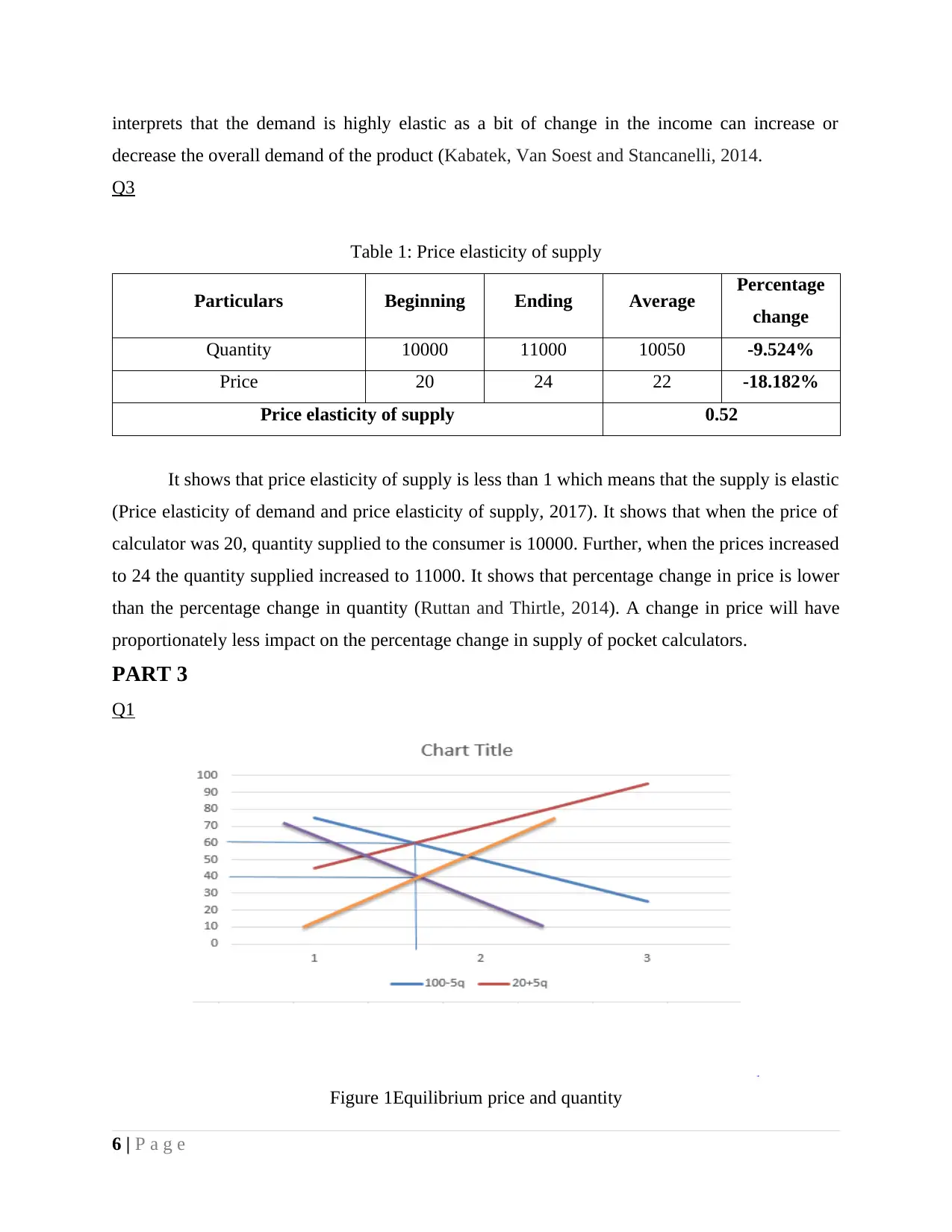
interprets that the demand is highly elastic as a bit of change in the income can increase or
decrease the overall demand of the product (Kabatek, Van Soest and Stancanelli, 2014.
Q3
Table 1: Price elasticity of supply
Particulars Beginning Ending Average Percentage
change
Quantity 10000 11000 10050 -9.524%
Price 20 24 22 -18.182%
Price elasticity of supply 0.52
It shows that price elasticity of supply is less than 1 which means that the supply is elastic
(Price elasticity of demand and price elasticity of supply, 2017). It shows that when the price of
calculator was 20, quantity supplied to the consumer is 10000. Further, when the prices increased
to 24 the quantity supplied increased to 11000. It shows that percentage change in price is lower
than the percentage change in quantity (Ruttan and Thirtle, 2014). A change in price will have
proportionately less impact on the percentage change in supply of pocket calculators.
PART 3
Q1
Figure 1Equilibrium price and quantity
6 | P a g e
decrease the overall demand of the product (Kabatek, Van Soest and Stancanelli, 2014.
Q3
Table 1: Price elasticity of supply
Particulars Beginning Ending Average Percentage
change
Quantity 10000 11000 10050 -9.524%
Price 20 24 22 -18.182%
Price elasticity of supply 0.52
It shows that price elasticity of supply is less than 1 which means that the supply is elastic
(Price elasticity of demand and price elasticity of supply, 2017). It shows that when the price of
calculator was 20, quantity supplied to the consumer is 10000. Further, when the prices increased
to 24 the quantity supplied increased to 11000. It shows that percentage change in price is lower
than the percentage change in quantity (Ruttan and Thirtle, 2014). A change in price will have
proportionately less impact on the percentage change in supply of pocket calculators.
PART 3
Q1
Figure 1Equilibrium price and quantity
6 | P a g e
⊘ This is a preview!⊘
Do you want full access?
Subscribe today to unlock all pages.

Trusted by 1+ million students worldwide
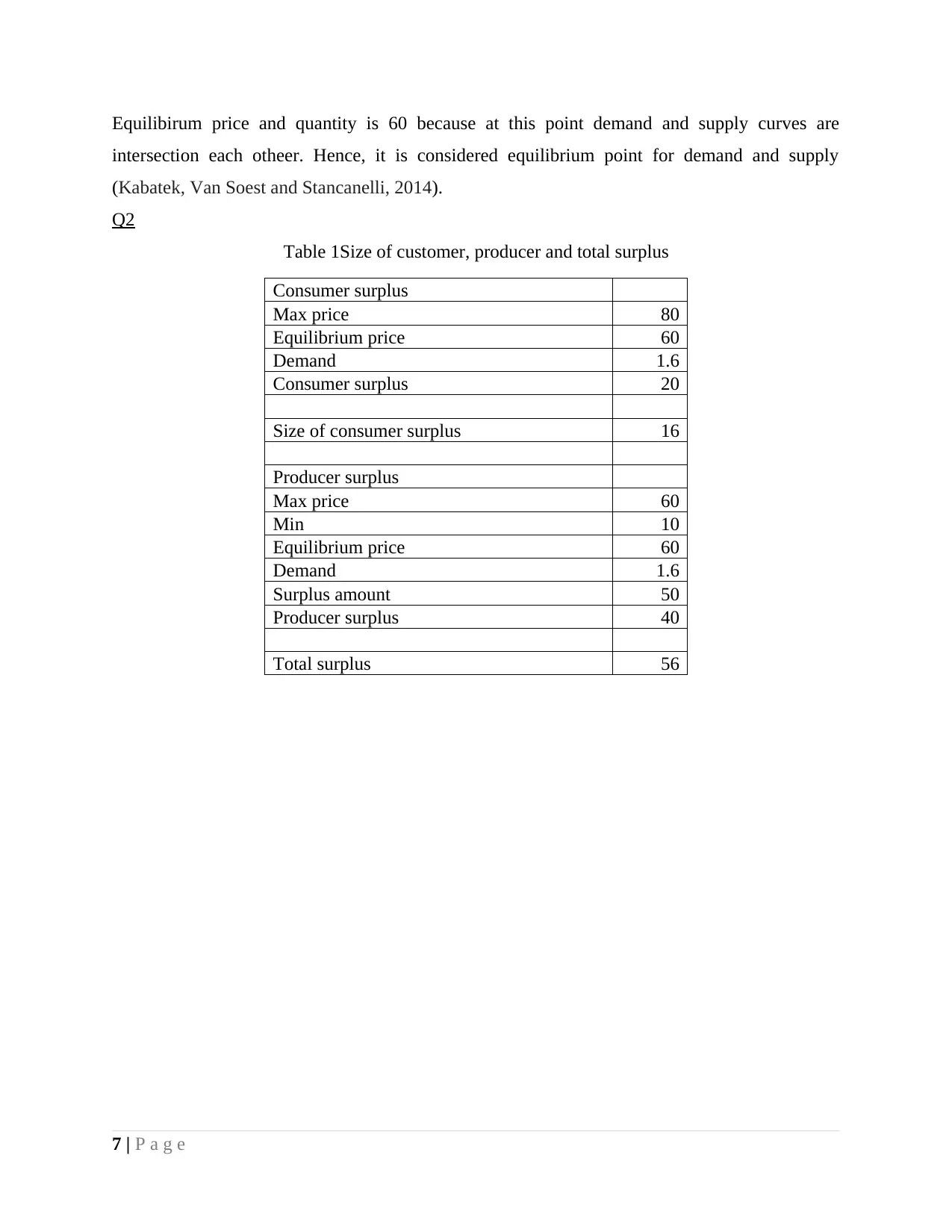
Equilibirum price and quantity is 60 because at this point demand and supply curves are
intersection each otheer. Hence, it is considered equilibrium point for demand and supply
(Kabatek, Van Soest and Stancanelli, 2014).
Q2
Table 1Size of customer, producer and total surplus
Consumer surplus
Max price 80
Equilibrium price 60
Demand 1.6
Consumer surplus 20
Size of consumer surplus 16
Producer surplus
Max price 60
Min 10
Equilibrium price 60
Demand 1.6
Surplus amount 50
Producer surplus 40
Total surplus 56
7 | P a g e
intersection each otheer. Hence, it is considered equilibrium point for demand and supply
(Kabatek, Van Soest and Stancanelli, 2014).
Q2
Table 1Size of customer, producer and total surplus
Consumer surplus
Max price 80
Equilibrium price 60
Demand 1.6
Consumer surplus 20
Size of consumer surplus 16
Producer surplus
Max price 60
Min 10
Equilibrium price 60
Demand 1.6
Surplus amount 50
Producer surplus 40
Total surplus 56
7 | P a g e
Paraphrase This Document
Need a fresh take? Get an instant paraphrase of this document with our AI Paraphraser
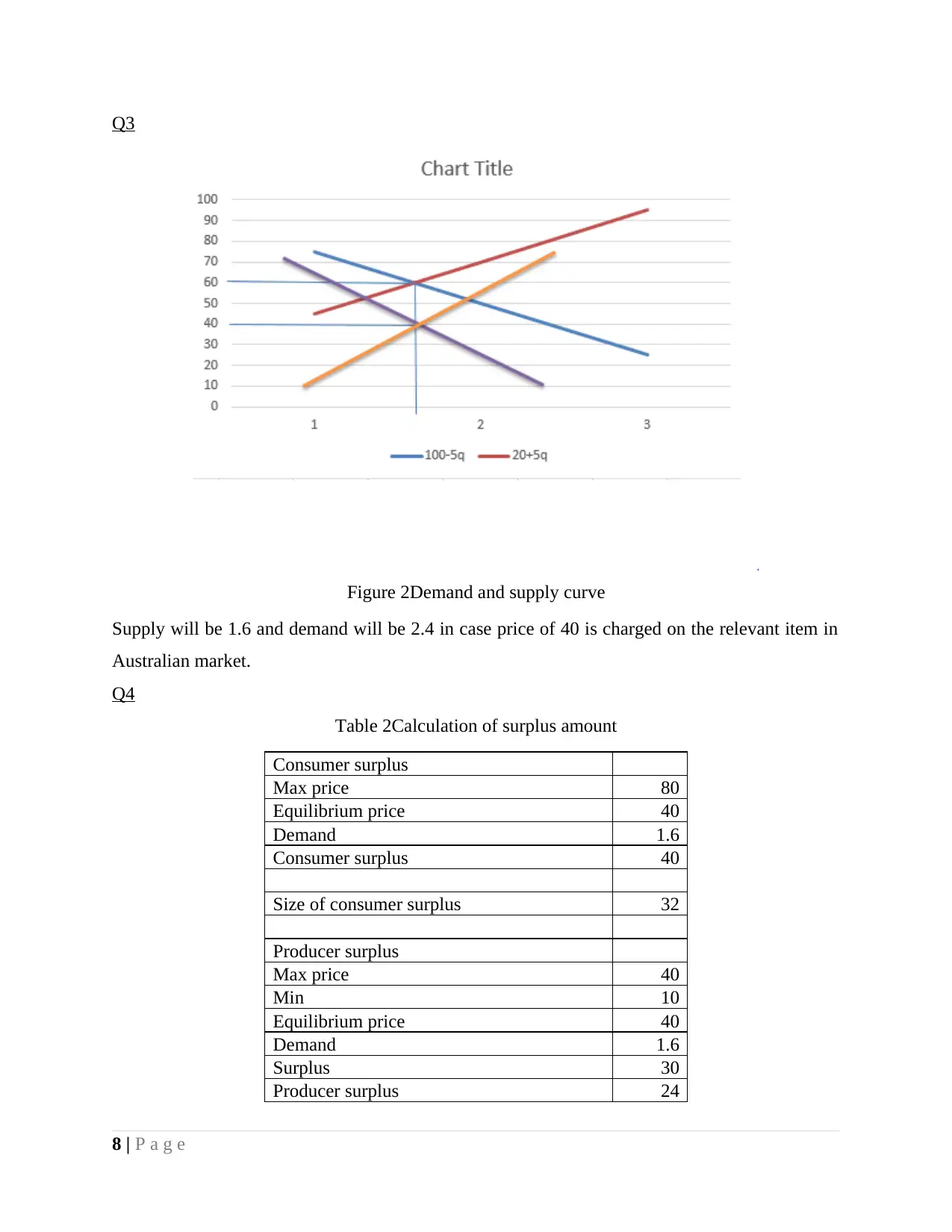
Q3
Figure 2Demand and supply curve
Supply will be 1.6 and demand will be 2.4 in case price of 40 is charged on the relevant item in
Australian market.
Q4
Table 2Calculation of surplus amount
Consumer surplus
Max price 80
Equilibrium price 40
Demand 1.6
Consumer surplus 40
Size of consumer surplus 32
Producer surplus
Max price 40
Min 10
Equilibrium price 40
Demand 1.6
Surplus 30
Producer surplus 24
8 | P a g e
Figure 2Demand and supply curve
Supply will be 1.6 and demand will be 2.4 in case price of 40 is charged on the relevant item in
Australian market.
Q4
Table 2Calculation of surplus amount
Consumer surplus
Max price 80
Equilibrium price 40
Demand 1.6
Consumer surplus 40
Size of consumer surplus 32
Producer surplus
Max price 40
Min 10
Equilibrium price 40
Demand 1.6
Surplus 30
Producer surplus 24
8 | P a g e

Total surplus 56
Firms are not better off because now surplus amount reduced for them from 40 to 24. Society is
better off as due to decline of equilibrium price from 60 to 40 more quantity can be purchased.
Workers are not better off because firms are earning less revenue and if downturn will happen in
economy they may loose their jobs.
Q5
Figure 3Demand and supply curve on imposition of tariff
On imposition of tariff of 10 on price demand and supply will change. At price of 40
supply was 1.3 which increased to 1.7 at price of 50. Hence, domestic supply will increase due to
elevation in tariff rate. Import which is reflected by demand was 2.2 at price of 40 and it
decreased to 2 when tariff of 10 charged and price is 50. Hence, it can be said that due to
imposition of tariff domestic product supply will increase and foreign product demand will
decrease.
9 | P a g e
Firms are not better off because now surplus amount reduced for them from 40 to 24. Society is
better off as due to decline of equilibrium price from 60 to 40 more quantity can be purchased.
Workers are not better off because firms are earning less revenue and if downturn will happen in
economy they may loose their jobs.
Q5
Figure 3Demand and supply curve on imposition of tariff
On imposition of tariff of 10 on price demand and supply will change. At price of 40
supply was 1.3 which increased to 1.7 at price of 50. Hence, domestic supply will increase due to
elevation in tariff rate. Import which is reflected by demand was 2.2 at price of 40 and it
decreased to 2 when tariff of 10 charged and price is 50. Hence, it can be said that due to
imposition of tariff domestic product supply will increase and foreign product demand will
decrease.
9 | P a g e
⊘ This is a preview!⊘
Do you want full access?
Subscribe today to unlock all pages.

Trusted by 1+ million students worldwide
1 out of 15
Related Documents
Your All-in-One AI-Powered Toolkit for Academic Success.
+13062052269
info@desklib.com
Available 24*7 on WhatsApp / Email
![[object Object]](/_next/static/media/star-bottom.7253800d.svg)
Unlock your academic potential
Copyright © 2020–2025 A2Z Services. All Rights Reserved. Developed and managed by ZUCOL.





